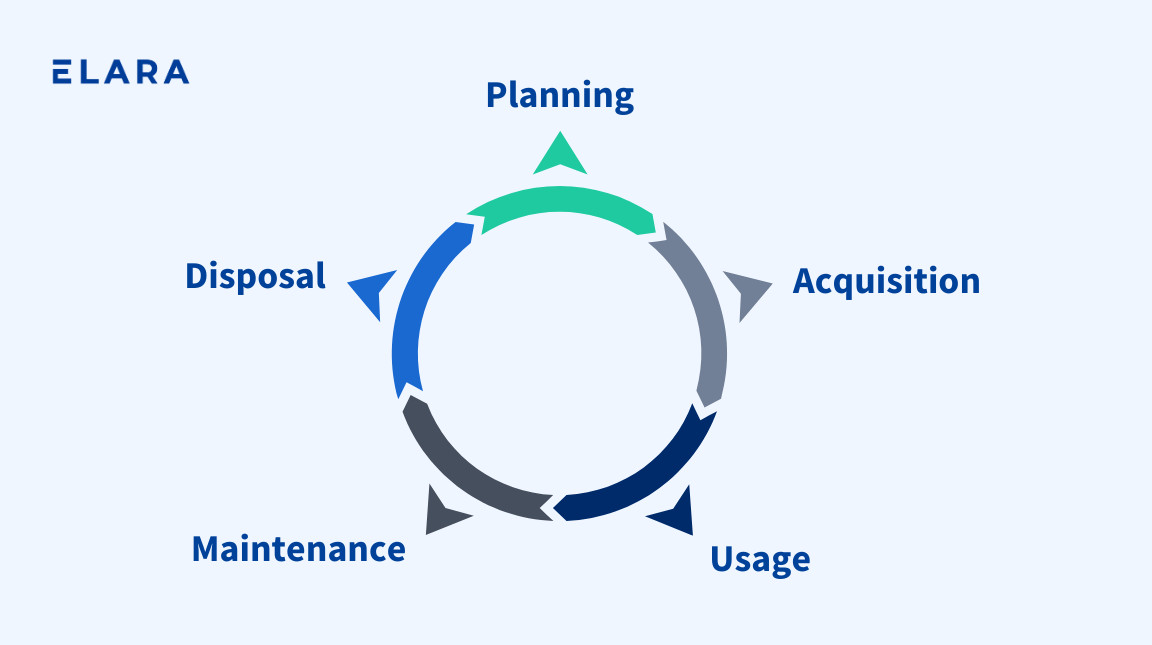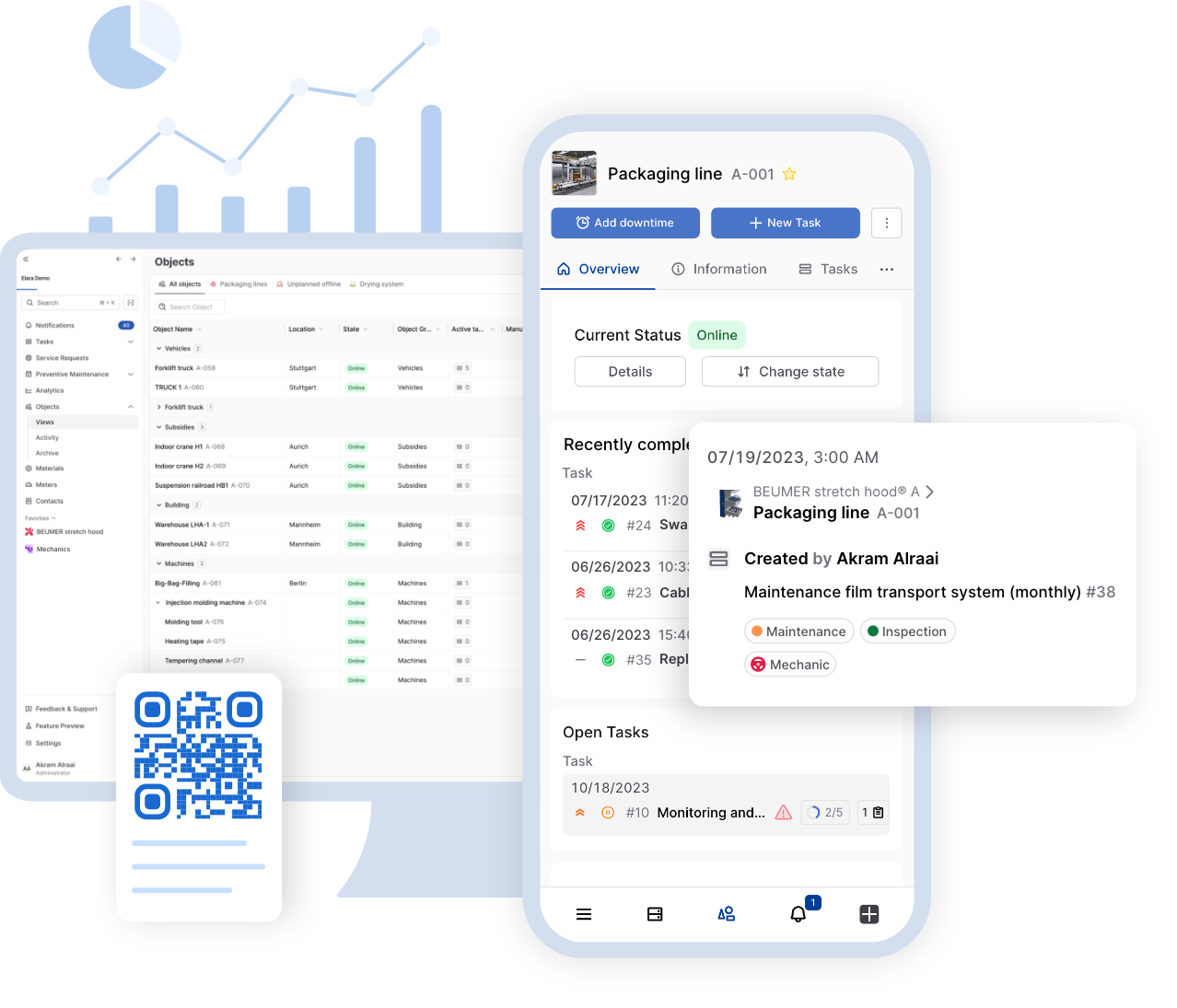Facility management plays a crucial role in maintaining the functionality, comfort, safety, and efficiency of buildings, equipment, and real estate. The goal is to operate all the facilities [...]

Facility management plays a crucial role in maintaining the functionality, comfort, safety, and efficiency of buildings, equipment, and real estate. The goal is to operate all the facilities efficiently, extend their lifespan, and reduce downtime. By employing the right strategies and technologies, businesses can enhance asset performance, leading to cost savings and, increased productivity. This approach is particularly crucial in capital-intensive industries, where effective facility management is vital for long-term success.
Important aspects of facility management
Comprehensive facility management consists of three essential elements that ensure the longevity of your assets:
Understanding the asset life cycle
The asset life cycle encompasses everything from the initial purchase decision to the final disposal when the asset is no longer needed. By implementing effective asset lifecycle management, companies can extend the lifespan of their resources, reduce maintenance costs, and enhance reliability. This approach minimizes the risk of unexpected failures, ensuring that assets provide maximum value throughout their operational life.
Key stages of the asset life cycle
An asset’s life cycle consists of five essential stages: planning, acquisition, usage, maintenance, and disposal. Although the usage and maintenance phases demand the most time and effort, each stage is critical in maximizing the overall benefits of the asset.
-
Planning
During the planning phase, you identify unmet needs within your organization. This stage involves brainstorming ideas and exploring potential solutions. For significant investments, it’s crucial to evaluate various options to find the most suitable solution.
-
Acquisition
After selecting the right investment, the next step is procurement. This process includes not only the purchase, but also transporting the system to your facility. Be sure to account for installation costs in your budget.
-
Usage
At this stage, you can operationalize the new system. Assess its requirements and devise strategies for optimal performance. Determine which maintenance strategies are most effective and create a maintenance plan to enhance efficiency and extend the equipment’s lifespan.
-
Maintenance
Execute the maintenance management plan, performing the necessary upkeep to ensure the system runs efficiently. Utilize maintenance checklists to guarantee that all tasks are completed regularly and thoroughly.
-
Disposal
Finally, it is time to dispose of the system when maintenance is no longer economical. Carry out a cost-benefit analysis to decide whether a new system makes more sense. Consider various options for disposal, such as resale or environmentally friendly disposal options.
Once the system is disposed of, the cycle starts again, and you begin planning for replacement.
2. Asset tracking
Real-time monitoring of assets is essential to understand their location, condition and usage. This accurate tracking enables companies to make informed decisions regarding maintenance requirements, asset replacement or disposal. Through effective asset tracking, potential problems can be identified early and appropriate action taken to increase uptime and efficiency.
3. Maintenance
Regular maintenance is key to extending the life of assets. It helps to identify potential problems at an early stage and avoid costly downtime. Preventive maintenance strategies play a central role here.

Advantages of effective facility management
Well-structured facility management offers companies numerous advantages that lead to a significant improvement in operational efficiency. One of the greatest strengths is cost reduction. Optimized maintenance strategies and the timely detection of potential problems can minimize costly repairs and downtime. Greater efficiency is another benefit, as companies can target their resources and maximize the use of their equipment. This also contributes to better capacity utilization, as equipment is used optimally without bottlenecks occurring. Finally, effective facility management reduces downtime, which increases productivity and improves the overall performance of the company. These benefits not only help to reduce costs, but also encourage a proactive and strategic approach to facility management.
Best practices for facility management
To ensure effective facility management, companies should consider various best practices. One key strategy is to implement a Computerized Maintenance Management System (CMMS) that provides a comprehensive overview of all assets and their maintenance status. With a CMMS, companies can create preventive maintenance schedules, efficiently manage maintenance work and monitor asset utilization. Additionally, staff training is crucial to ensure that all employees are familiar with the latest technologies and processes. Data analysis is another key factor. By collecting and evaluating performance data, companies can make informed decisions and strive for continuous improvement. In addition, close collaboration between departments is important to leverage synergies and promote holistic asset management.
Elara’s perspective
Digitalization has revolutionized facility management by providing modern software solutions that significantly improve the entire process. These technologies enable seamless integration of data, allowing companies to access information in real time to make informed decisions.
We see automation as another key element. It reduces manual intervention and minimizes errors while increasing efficiency. For example, automated maintenance reminders and notifications can ensure that no critical maintenance work is overlooked. In addition, cloud-based solutions enable better accessibility and collaboration, allowing teams to work from anywhere. Digitalization not only promotes efficiency, but also supports transparency and traceability in asset management, which is essential for strategic planning and decision-making.
To see how our customers have successfully implemented these changes and reaped the benefits of innovative maintenance strategies, take a look at our success stories.
[In the age of AI, you never know if you’re reading something copy and pasted directly from ChatGPT, or if an actual human sat down to write this with some cool facts from their boss or operations team. That’s why we created a short and simple introduction to how we create content at Elara.]




